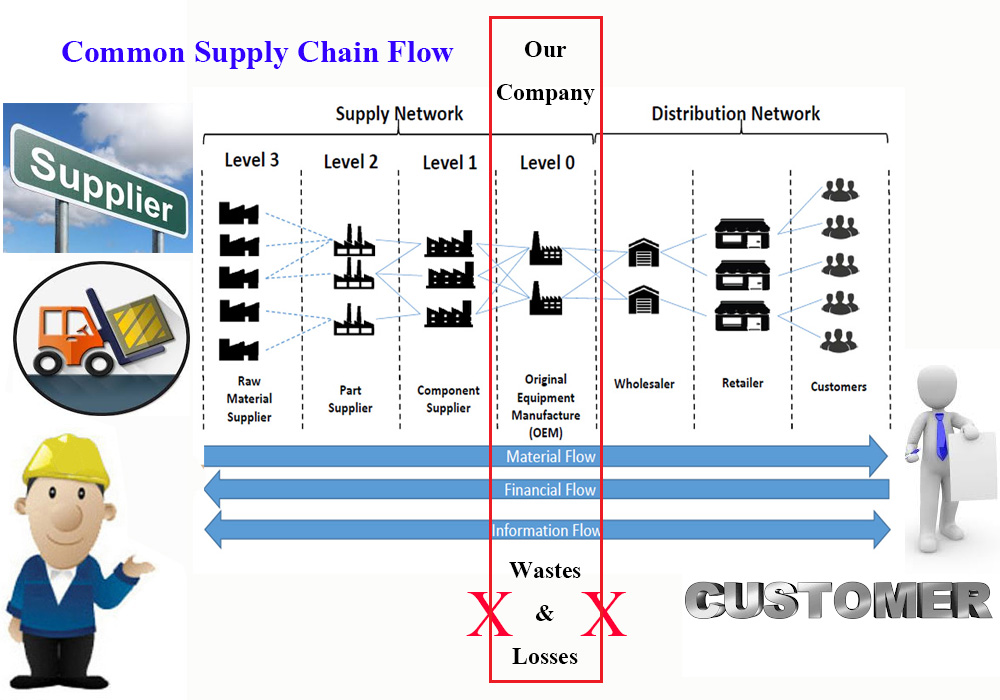ดัชนีต้นทุนโลจิสติกส์ (Logistics Cost Index) และต้นทุนโลจิสติกส์อุตสาหกรรม (Manufacturing Logistics Costs)

ดัชนีต้นทุนโลจิสติกส์ (Logistics Cost Index) คือ ตัวเลขที่ใช้วัดการเปลี่ยนแปลงต้นทุนด้านโลจิสติกส์ ณ เวลาใดเวลาหนึ่ง เปรียบเทียบกับระยะเวลา ณ ปีฐาน
โครงสร้างดัชนีต้นทุนโลจิสติกส์ประกอบด้วย 4 หมวดได้แก่
1. ต้นทุนการเก็บรักษาสินค้าคงคลัง (Inventory Carrying Cost)
2. ต้นทุนการจัดการคลังสินค้า (Warehousing Cost)
3. ต้นทุนการขนส่งสินค้า (Transportation Cost)
4. ต้นทุนการบริหารจัดการ (Administration Cost)
ข้อดีของการจัดทำดัชนีต้นทุนโลจิสติกส์
1. เป็นข้อมูลประกอบการกำหนดนโยบาย มาตรการและแผนการพัฒนาด้านโลจิสติกส์ เพื่อลดต้นทุนด้านโลจิสติกส์ของผู้ประกอบการและเพิ่มขีดความสามารถในการแข่งขัน
2. เป็นข้อมูลพื้นฐานในการศึกษาวิเคราะห์วิจัยทางเศรษฐกิจในด้านต่างๆที่เกี่ยวข้อง อาทิ ราคาน้ำมัน อัตราแลกเปลี่ยนเงินตราต่างประเทศ ภาวะเงินเฟ้อ
3. เป็นข้อมูลประกอบการพิจารณาต้นทุนโลจิสติกส์ และประกอบการคิดต้นทุนโลจิสติกส์ที่เปลี่ยนแปลงในแต่ละไตรมาส
4. เป็นข้อมูลเปรียบเทียบสมรรถนะการดำเนินกิจกรรมโลจิสติกส์ เพื่อประกอบการตัดสินใจลงทุนของผู้ประกอบการแต่ละอุตสาหกรรมทั้งภายในประเทศและต่างประเทศ
5. เป็นเครื่องบ่งชี้ภาวะด้านต้นทุนโลจิสติกส์ของอุตสาหกรรมภายในประเทศ
ข้อเสียของการจัดทำดัชนีต้นทุนโลจิสติกส์
1. จำเป็นต้องใช้ข้อมูลสถิติด้านภาวะเศรษฐกิจของปีฐานที่แน่นอน และครอบคลุมอย่างแท้จริงจึงจะได้ข้อมูลที่แน่นอน
2. ใช้ระยะเวลาในการดำเนินงานค่อนข้างมาก และใช้ข้อมูลค่อนข้างมากเช่นภาวะเงินเฟ้อ ราคาน้ำมัน เป็นต้น
3. ผู้ประกอบการเอกชน SME ได้รับผลประโยชน์น้อยกว่าผู้ประกอบการรายใหญ่ที่สามารถใช้ข้อมูลในการคาดการณ์ภาวะเศรษฐกิจได้
ต้นทุนโลจิสติกส์ต่อยอดขาย
ต้นทุนจากกิจกรรมด้านโลจิสติกส์ จากการบริการลูกค้า การขนส่ง การคลังสินค้า กระบวนการคำสั่งซื้อและข้อมูล ปริมาณการผลิต และสินค้าคงคลัง ตลอดห่วงโซ่อุปทาน เปรียบเทียบกับยอดขายในแต่ละปี
ข้อดีของการจัดทำต้นทุนโลจิสติกส์ต่อยอดขาย
1. สามารถใช้เป็นดัชนีในการลดต้นทุนจากกิจกรรมการผลิตของผู้ประกอบการ
2. สามารถใช้เป็นเครื่องมือที่สำคัญในการแข่งขันทางด้านธุรกิจ
3. การใช้สินทรัพย์มีความคุ้มค่ามากขึ้น
4. ผู้ประกอบการสามารถดำเนินการได้เอง หรือจ้างที่ปรึกษาดำเนินการได้
ข้อเสียของการจัดทำต้นทุนโลจิสติกส์
1. หากต้องการข้อมูลที่จะสามารถเปรียบเทียบหรือแข่งขันกับสากลได้นั้น ต้องใช้ข้อมูลระดับสากลและข้อมูลกลุ่มอุตสาหกรรมในประเทศเป็นตัวเปรียบเทียบ
2. เป็นข้อมูลของแต่ละอุตสาหกรรมหรือกลุ่มอุตสาหกรรมที่ดำเนินการ
3. หากเป็นหน่วยงานอื่นภายนอกที่จะทำการศึกษา อาจได้ข้อมูลไม่ครบถ้วนหรือมีความคลาดเคลื่อน เนื่องจากข้อมูลบางตัวเป็นความลับของทางบริษัท โดยเฉพาะต้นทุนการผลิต หรือยอดขาย
ต้นทุนโลจิสติกส์อุตสาหกรรม (Manufacturing Logistics Costs)
Manufacturing Logistics Costs |
||||
|
Percentage of Sales |
Internal Costs |
Outsourced Costs |
Inventory Carrying Costs |
Total Logistics Costs |
|
Animal food |
3.09% |
5.14% |
1.98% |
10.22% |
|
Sugar and confectionery products |
1.99% |
1.59% |
1.51% |
5.09% |
|
Fruit and vegetable preserving and specialty food |
2.70% |
1.62% |
2.75% |
7.07% |
|
Dairy product |
3.10% |
3.73% |
1.34% |
8.18% |
|
Meat product |
1.89% |
1.14% |
0.94% |
3.97% |
|
Seafood product preparation and packaging |
2.39% |
0.97% |
1.92% |
5.27% |
|
Miscellaneous food |
4.58% |
9.34% |
1.75% |
15.67% |
|
Tobacco |
19.33% |
0.27% |
2.77% |
22.37% |
|
Textile and textile product mills |
3.26% |
0.67% |
1.44% |
5.37% |
|
Clothing |
3.54% |
0.31% |
3.54% |
7.39% |
|
Leather and allied product |
3.94% |
1.14% |
3.50% |
8.59% |
|
Wood product |
3.21% |
2.19% |
2.76% |
8.17% |
|
Pulp, paper and paperboard mills |
2.63% |
6.02% |
2.33% |
10.98% |
|
Converted paper product |
3.10% |
1.44% |
1.77% |
6.31% |
|
Printing and related product support activities |
2.58% |
1.59% |
0.94% |
5.10% |
|
Petroleum and coal product |
0.29% |
0.70% |
0.94% |
1.92% |
|
Basic chemical |
1.38% |
2.18% |
1.37% |
4.93% |
|
Resin, synthetic, rubber and artificial synthetic fibres and filaments |
0.92% |
1.78% |
1.41% |
4.11% |
|
Pesticides, fertilizer and other agricultural chemical |
2.48% |
2.59% |
2.42% |
7.49% |
|
Pharmaceutical and medicine |
1.52% |
0.41% |
3.86% |
5.78% |
|
Miscellaneous chemical |
2.08% |
4.65% |
2.09% |
8.82% |
|
Plastic product |
2.42% |
0.68% |
1.69% |
4.80% |
|
Rubber product |
3.28% |
1.93% |
1.35% |
6.56% |
|
Cement and concrete product |
10.03% |
3.11% |
1.50% |
14.64% |
|
Miscellaneous non-metallic mineral product |
3.49% |
6.31% |
1.83% |
11.63% |
|
Primary metals |
1.68% |
2.09% |
2.03% |
5.80% |
|
Fabricated metal product |
2.96% |
1.78% |
1.84% |
6.59% |
|
Machinery |
2.26% |
0.97% |
2.27% |
5.50% |
|
Computer and peripheral equipment |
1.51% |
0.95% |
3.90% |
6.36% |
|
Electric product |
2.72% |
0.78% |
3.13% |
6.62% |
|
Household appliance |
2.67% |
0.89% |
1.79% |
5.35% |
|
Electrical equipment |
1.79% |
1.96% |
1.87% |
5.62% |
|
Motor vehicle |
0.70% |
1.07% |
0.68% |
2.45% |
|
Motor vehicle body and trailer |
2.35% |
1.19% |
1.79% |
5.34% |
|
Motor vehicle parts |
2.72% |
0.97% |
1.13% |
4.82% |
|
Aerospace product and parts |
2.30% |
0.56% |
3.49% |
6.34% |
|
Railroad rolling stock |
2.90% |
0.81% |
0.82% |
4.53% |
|
Ship and boat building |
3.27% |
1.09% |
1.27% |
5.63% |
|
Other transportation equipment |
2.46% |
1.26% |
0.78% |
4.50% |
|
Furniture related product |
2.81% |
1.11% |
1.49% |
5.40% |
|
Miscellaneous manufacturing |
3.04% |
0.91% |
2.86% |
6.81% |
|
Total manufacturing |
2.34% |
1.59% |
1.77% |
5.71% |
|
Logistics Aggregate Data |
||||||
|
|
Manufacturing Canada |
Manufacturing U.S. |
Wholesale Canada |
Wholesale U.S. |
Retail Canada |
Retail U.S. |
|
Internal Cost |
15.154 |
8.3347 |
9.69 |
7.2675 |
5.544 |
4.65696 |
|
Outsourcing |
9.366 |
16.6703 |
1.366 |
1.422917 |
0.491 |
1.559647 |
|
Inventory Carrying Cost |
9.881985 |
8.908321 |
7.817786 |
6.661961 |
10.32336 |
7.84517 |
|
Source: Statistics Canada, Jacobson Consulting and Authors Calculations, in Canadian Based Factor (based in billions of Canadian dollars) |
||||||
|
Logistics Internal Cost Data |
||
|
|
Share of Gross Margin |
Share of GDP |
|
Retail Trade |
11.5% |
19% |
|
Motor Vehicle and parts dealers |
14.9% |
|
|
Furniture and home furnishings stores |
15.3% |
|
|
Electronics and appliance stores |
9.2% |
|
|
Building materials and garden equipment and supplies dealers |
29.2% |
|
|
Food and beverage stores |
7.0% |
|
|
Health and personal care stores |
7.5% |
|
|
Gasoline stations |
1.7% |
|
|
Clothing and clothing accessories stores |
5.8% |
|
|
Sporting goods, hobby, book and music stores |
7.3% |
|
|
General merchandise stores |
18.4% |
|
|
Miscellaneous store retailers |
11.6% |
|
|
Non-store retailers |
24.3% |
|
|
Source: Statistics Canada, Census, Input-Output Data and Jacobson Consulting Calculations |
||
